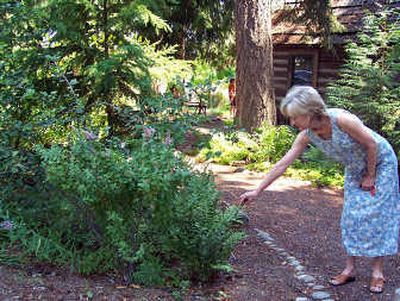Naturally native

SANDPOINT – With all the newcomers flocking to North Idaho it’s easy to take the natives for granted – especially the tiny green ones hiding out in the woods, or the giant ones towering over our home. We’re talking about true Idaho natives, such as the Rocky Mountain maple, Oregon grape, wild blue flax and shaggy mane mushroom, many of which have been here for centuries. But thanks to the efforts of the Idaho Native Plant Society, these old-timers are being helped to gain the recognition and respect they deserve.
Lois Wythe, founder of the Kinnikinnick chapter of INPS, describes its beginnings. “In 1997, a very strong interest in native plants of the North Idaho region was beginning to be noticeable in the Master Gardener classes … and in inquiries to local nurseries from people who wanted to learn more about our native plants and how they might be incorporated into home landscape habitats as well as enjoyed in the wild. More than 60 people responded with interest in the formation of the Sandpoint chapter of the Native Plant Society.”
“Our mission,” said Carol Jenkins, chairwoman of the conservation committee of the Kinnikinnick chapter, “is to foster an understanding and appreciation of Idaho’s native flora and its habitats, to encourage the responsible use of native plants in landscaping and restoration, and to advocate conservation of this rich natural heritage for future generations.”
Of course, it’s tough to appreciate something you can’t identify, so the INPS has taken steps to educate any who want to learn through a host of activities and programs including informative monthly meetings, field trips to view native plants in their natural habitat, and the Kinnikinnick Journal, a newsletter highlighting upcoming events and programs.
One of the group’s greatest accomplishments is the North Idaho Native Plant Arboretum in Sandpoint. “It began when the Sandpoint City Council enthusiastically approved our request for space in Lakeview Park in December of 1998,” Wythe said. Eight North Idaho habitats are duplicated in the arboretum including dry forest, sub alpine, and the rare Idaho interior rain forest.
Don’t miss the unique section devoted to wild medicinal plants, most still in use today, such as wintergreen – used in gargles, toothpaste and gum – and Lungwort, found in multiple remedies for coughs and congestion. Many medicinal plants we think of as being “native” were originally brought here by traders, colonists, soldiers, and indigenous peoples and have naturalized in the wild over the past few hundred years. Because of this history, some naturalized plants are included in the medicinal exhibit. They’re set apart from the natives by a red dot on their labels.
Another major and ongoing effort of the Kinnikinnick chapter is the creation of the Eurasian milfoil educational sign at the WaterLife Discovery Center, on the Pend Oreille River in Sandpoint. “In April 2006,” says Jenkins, “we hosted a free public forum on the invasive noxious weed. Following the success of the forum, we applied for and received a grant from the Idaho state Department of Agriculture Eurasian Watermilfoil Control Program to design and construct a sign.”
The WaterLife Discovery Center is a self-guided educational facility for students and families to learn about the major role waterways play in shaping our environment, and how responsible use of it increases the health of this aquatics ecosystem and our enjoyment of it. “With the dramatic infestation of noxious Eurasian watermilfoil,” adds Jenkins, “it seemed like the perfect time and perfect place to provide this educational outreach to our community.”
Under the guidance of Mark Taylor, Discovery Center coordinator, graphic design for the 4-foot by 4-foot sign is being completed by Fish and Game and will be installed later this summer. It will be a great addition to the native plant landscaping already in place thanks to the Kinnikinnick chapter.
If you’d like to learn more about Idaho’s true natives you might want to attend “Plants, Fire and Climate Change,” a presentation by Sam Cushman, research ecologist from the Rocky Mountain Research Station, to be held Sept. 22. The public is also invited to attend any of the monthly INPS meetings, (on hiatus for summer, but resuming again in September) held on the fourth Saturday morning of each month at the Sandpoint Community Hall.